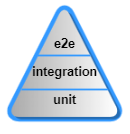Testing Standards
Stephen Fuqua
Ian Christopher (Deactivated)
Owned by Stephen Fuqua
General Principles
- Test-driven development using the red-green-refactor method is encouraged.
- Definitions:

- Unit tests. Unit tests are run in isolation, with limited (ideally no) hard-coded dependencies on other classes, and absolutely no dependencies on external resources such as a database, filesystem, web service, or similar.
- Integration tests. These are tests that do connect to external resources, and therefore may need additional setup to prepare those resources and teardown to clean them up afterward.
- End-to-end (E2E) tests. These are a special case of integration test where the interaction with the system is driven end-to-end through a graphical user interface, console application, or other long-running process.
- Ed-Fi test suites usually follow the test pyramid philosophy:
- Write a lot of unit tests, with high coverage for all but the most trivial code.
- Write integration tests where appropriate; though fewer in number, they are essential for ensuring that parts work together. Why fewer? Because they are usually hard to write and harder to maintain.
- Build end-to-end tests sparingly, as they are the most expensive to execute and to maintain.
- When joining an existing project, always look at the prevailing testing conventions and follow them when creating new tests or modifying existing ones. In consultation with the primary development team and Ed-Fi Alliance tech staff, those prevailing conventions are open to modification — but only under those two conditions.
- When it seems impossible to write a unit test, take another look: this usually signals the presence of a dependency that can be extracted to an Adapter / Wrapper class and injected into the class under test. The Adapter / Wrapper is usually not covered by unit tests and should contain the minimum logic needed to redirect arguments to the real dependency class.
Prefer test methods that assert a single truth. However, multiple assertions may be necessary in cases where it is important to assert an object is not null before asserting a truth on one of its properties. Note that the following examples use Shouldly methods instead of NUnit's "Assert.XYZ" methods.
// Bad [Test] public void Given_some_condition_then_expect_some_results() { // ... arrange and act (execute) // ... and now Assert / validate the results result.PropertyOne.ShouldBe(1); result.PropertyTwo.ShouldBe("two"); } // Good [Test] public void Given_some_condition_then_expect_property_one_to_be_1() { // ... arrange and act (execute) // ... and now Assert / validate the results result.PropertyOne.ShouldBe(1); } [Test] public void Given_some_condition_then_expect_property_two_to_be_2() { // ... arrange and act (execute) // ... and now Assert / validate the results result.PropertyTwo.ShouldBe("two"); } // In many cases, the test suite will be rearranged so that the // test setup method will execute the test and each test method // would contain only one line - the single assertion.Guard Clause Assertions// We don't want a null reference exception, and therefore introduce // a not-null guard clause assertion. The assertions with // 'results.Value.Any' arguably should have been in a separate method. [Test] public void A_test_with_guard_clauses() { // ... arrange and act (execute) // ... and now Assert / validate the results result.ShouldNotBeNull(); // Safely use multiple assertions once the guard clause // has been satisfied. Two styles shown: // native NUnit style: Assert.Multiple( () => { result.Value.Length.ShouldBe(6); result.Value.Any(x => x.GetType() != typeof(NpgsqlParameter)) .ShouldBeFalse(); }); // preferred Shouldly style: result.ShouldSatisfyAllConditions( () => result.Value.Length.ShouldBe(6), () => result.Value.Any(x => x.GetType() != typeof(NpgsqlParameter)) .ShouldBeFalse(); ); }Use fake objects appropriately. Mocks are not stubs; take care not to abuse mocks by making unit tests tightly coupled to implementation.
The FakeItEasy framework does not make a strong distinction between mocks and stubs. Nevertheless, the point stands that mocks can be taken overboard, which results in brittle tests.
Project-Specific Guidance
- ODS Platform Testing, covering the ODS / API and its associated utilities (e.g., code generation, db deploy, migration utility)
References
Excellent articles and online resources on the practice of testing:
- Best Practices in Test-Driven, Object Oriented, Green- and Brownfield Development, a guide by Ed-Fi software architect Stephen Fuqua
- xUnit Test Patterns, by Gerard Meszaros
- Software Testing Guide, articles by Martin Fowler and friends on his website
- Is TDD Dead?, a series of conversations between Kent Beck, David Heinemeier Hansson, and Martin Fowler
Good books on testing and designing for testability:
- Working Effectively with Legacy Code, by Michael C. Feathers
- Agile Principles, Patterns, and Practices in C#, by Robert C. Martin and Micah Martin
- Clean Code: A Handbook of Agile Software Craftsmanship, by Robert C. Martin
- Refactoring: Improving the Design of Existing Code, by Martin Fowler
- Design Patterns: Elements of Reusable Object-Oriented Software, by Erich Gamma, Richard Helm, Ralph Johnson, and John Vlissides
- Enterprise Integration Patterns: Designing, Building, and Deploying Messaging Solutions, by Gregor Hohpe, Bobby Woolf, et al.
- Implementation Patterns, by Kent Beck
- Patterns of Enterprise Application Architecture, by Martin Fowler, et al.
Contents